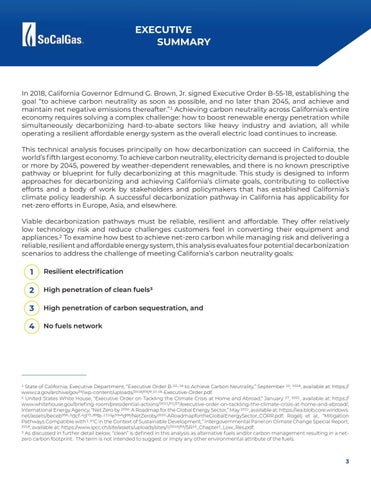EXECUTIVE SUMMARY
In 2018, California Governor Edmund G. Brown, Jr. signed Executive Order B-55-18, establishing the goal “to achieve carbon neutrality as soon as possible, and no later than 2045, and achieve and maintain net negative emissions thereafter.”1 Achieving carbon neutrality across California’s entire economy requires solving a complex challenge: how to boost renewable energy penetration while simultaneously decarbonizing hard-to-abate sectors like heavy industry and aviation, all while operating a resilient affordable energy system as the overall electric load continues to increase. This technical analysis focuses principally on how decarbonization can succeed in California, the world’s fifth largest economy. To achieve carbon neutrality, electricity demand is projected to double or more by 2045, powered by weather-dependent renewables, and there is no known prescriptive pathway or blueprint for fully decarbonizing at this magnitude. This study is designed to inform approaches for decarbonizing and achieving California’s climate goals, contributing to collective efforts and a body of work by stakeholders and policymakers that has established California’s climate policy leadership. A successful decarbonization pathway in California has applicability for net-zero efforts in Europe, Asia, and elsewhere. Viable decarbonization pathways must be reliable, resilient and affordable. They offer relatively low technology risk and reduce challenges customers feel in converting their equipment and appliances.2 To examine how best to achieve net-zero carbon while managing risk and delivering a reliable, resilient and affordable energy system, this analysis evaluates four potential decarbonization scenarios to address the challenge of meeting California’s carbon neutrality goals:
1
Resilient electrification
2
High penetration of clean fuels3
3
High penetration of carbon sequestration, and
4
No fuels network
1 State of California, Executive Department, “Executive Order B-55-18 to Achieve Carbon Neutrality,” September 10, 2018, available at: https:// www.ca.gov/archive/gov39/wp-content/uploads/2018/09/9.10.18-Executive-Order.pdf. 2 United States White House, “Executive Order on Tackling the Climate Crisis at Home and Abroad,” January 27, 2021, available at: https:// www.whitehouse.gov/briefing-room/presidential-actions/2021/01/27/executive-order-on-tackling-the-climate-crisis-at-home-and-abroad/; International Energy Agency, “Net Zero by 2050: A Roadmap for the Global Energy Sector,” May 2021, available at: https://iea.blob.core.windows. net/assets/beceb956-0dcf-4d73-89fe-1310e3046d68/NetZeroby2050-ARoadmapfortheGlobalEnergySector_CORR.pdf; Rogelj et al., “Mitigation Pathways Compatible with 1.5°C in the Context of Sustainable Development,” Intergovernmental Panel on Climate Change Special Report, 2018, available at: https://www.ipcc.ch/site/assets/uploads/sites/2/2019/05/SR15_Chapter2_Low_Res.pdf. 3 As discussed in further detail below, “clean” is defined in this analysis as alternative fuels and/or carbon management resulting in a netzero carbon footprint. The term is not intended to suggest or imply any other environmental attribute of the fuels.
3
